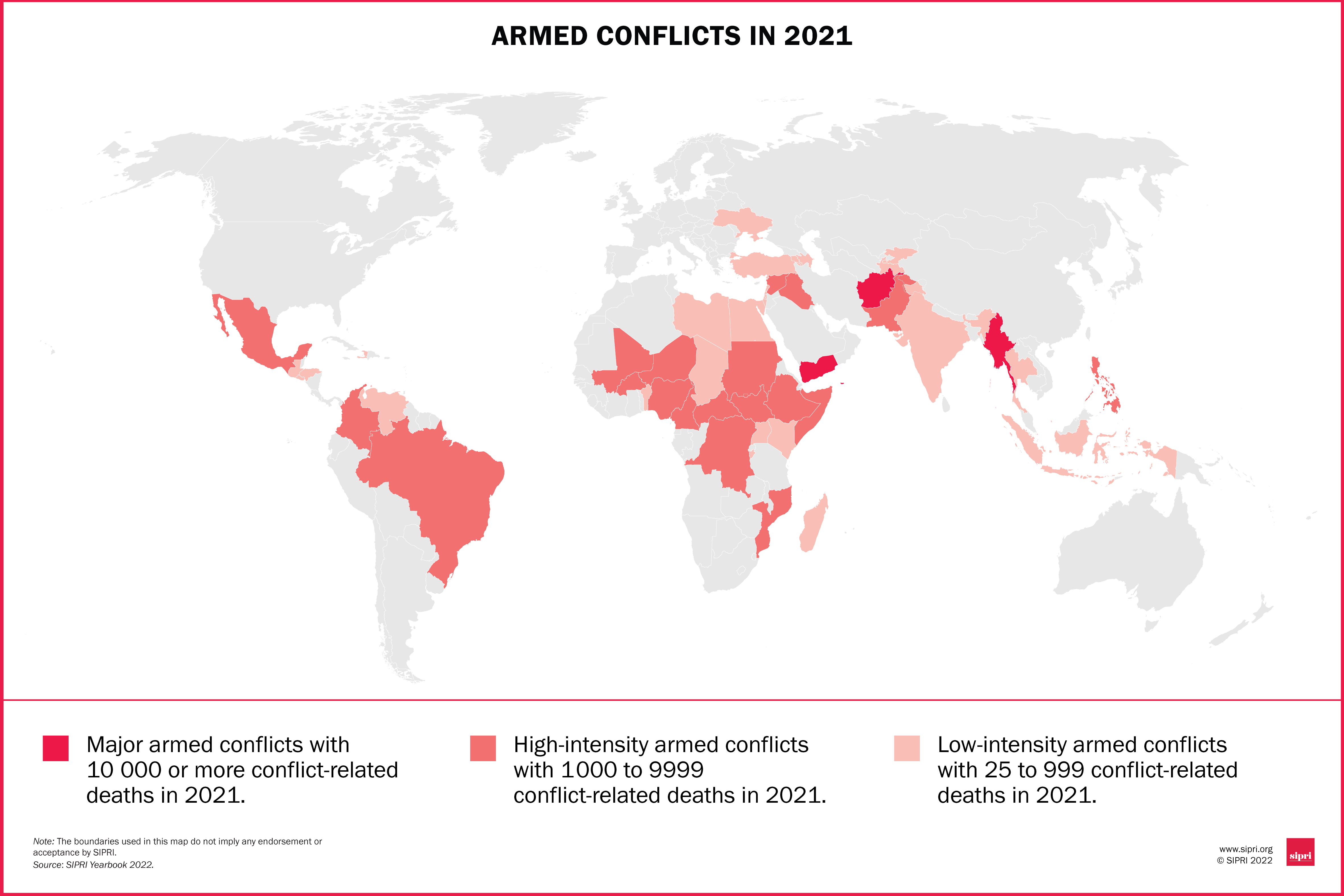2. Global developments in armed conflicts, peace processes and peace operations
Overview, Ian Davis and Claudia Pfeifer Cruz [PDF]
I. Tracking armed conflicts and peace processes, Ian Davis [PDF]
II. Global and regional trends and developments in multilateral peace operations, Claudia Pfeifer Cruz, Jaïr van der Lijn and Timo Smit [PDF]
III. Table of multilateral peace operations, 2021, Claudia Pfeifer Cruz [PDF]
Active armed conflicts occurred in at least 46 states in 2021 (one fewer than in 2020): 8 were in the Americas, 9 in Asia and Oceania, 3 in Europe, 8 in the Middle East and North Africa (MENA) and 18 in sub-Saharan Africa. As in preceding years, most took place within a single country (intra-state), between government forces and one or more armed non-state group(s). Three were major armed conflicts (with more than 10 000 conflict-related deaths in the year): Afghanistan, Yemen and Myanmar. A total of 19 were high-intensity armed conflicts (with 1000–9999 conflict-related deaths): Nigeria, Ethiopia, Mexico, Syria, the Democratic Republic of the Congo, Brazil, Somalia, Iraq, Burkina Faso, South Sudan, Mali, Sudan, the Central African Republic, Niger, Cameroon, Pakistan, Colombia, Mozambique and the Philippines. Only three armed conflicts were fought between states: the low-level border clashes between India and Pakistan; Armenia and Azerbaijan; and Kyrgyzstan and Tajikistan. Two other armed conflicts were fought between state forces and armed groups aspiring to statehood (between Israel and the Palestinians and between Turkey and the Kurds).

Consequences of armed conflict
The total estimated number of conflict-related fatalities increased to about 150 000 in 2021, which was 13 per cent higher than in 2020. The rise was driven by significant increases in fatalities in Asia and Oceania (up by 59 per cent from 2020)—mostly due to increases in Afghanistan, Myanmar and Pakistan—and sub-Saharan Africa (up by 19 per cent). Estimated conflict-related fatalities fell for the third consecutive year in MENA.
While conflict-related fatalities have generally shown a downward trend in recent years, other impacts of armed conflict (sometimes in combination with additional factors) appear to have increased in severity, including population displacement, food insecurity, humanitarian needs and violations of international humanitarian law.
Peace agreements
Most peace processes either stalled or suffered serious set-backs during 2021. Nonetheless, some of the greatest decreases in armed violence in 2021 took place in contexts where ceasefires and power-sharing agreements had been reached in 2020 (e.g. in Libya, Nagorno-Karabakh and Syria). The Covid-19 pandemic had minimal impact on armed conflicts in 2021—in most cases, armed conflict levels persisted or even increased.
Trends in multilateral peace operations
There were 63 active operations in 2021, one more than the previous year. Three operations ended in 2021: the North Atlantic Treaty Organization-led Resolute Support Mission (RSM) in Afghanistan; the African Union (AU) Human Rights Observers and Military Experts Mission in Burundi; and the Organization for Security and Co-operation in Europe Observer Mission at the Russian Checkpoints Gukovo and Donetsk. Four operations started: the United Nations Integrated Transition Assistance Mission in Sudan; the Russian–Turkish Joint Monitoring Centre in Azerbaijan; the Southern Africa Development Community Mission in Mozambique; and the European Union Military Training Mission in Mozambique.
The number of personnel deployed in multilateral peace operations decreased by 12 per cent during 2021, to reach 111 858 on 31 December 2021. This reduction was mainly driven by the closing of two multilateral peace operations, namely the RSM and the UN–AU Hybrid Operation in Darfur, which completed its mandate on 31 December 2020. The UN remained the leading organization in the field, with responsibility for about one third of all multilateral peace operations and more than two thirds of all personnel.
In 2021 the AU Mission in Somalia continued to be the largest multilateral peace operation. Ethiopia remained the top troop contributor, followed by Uganda and Bangladesh. In 2021 the annual fatality rate for hostile deaths of international personnel in UN peace operations increased again after having fallen in 2020. The UN Multi-dimensional Integrated Stabilization Mission in Mali continued to be the deadliest UN peace operation in terms of both hostile deaths and overall fatalities.
The number of operations that are not ‘multilateral peace operations’ (as defined by SIPRI) continued to increase in 2021, with the deployment of the joint inter-national ‘peacekeeping mission’ to the Solomon Islands. Another trend in 2021 was the intensification of geo-political rivalries between Western countries and Russia, China or both, which affected mission mandates, closures and restructuring.